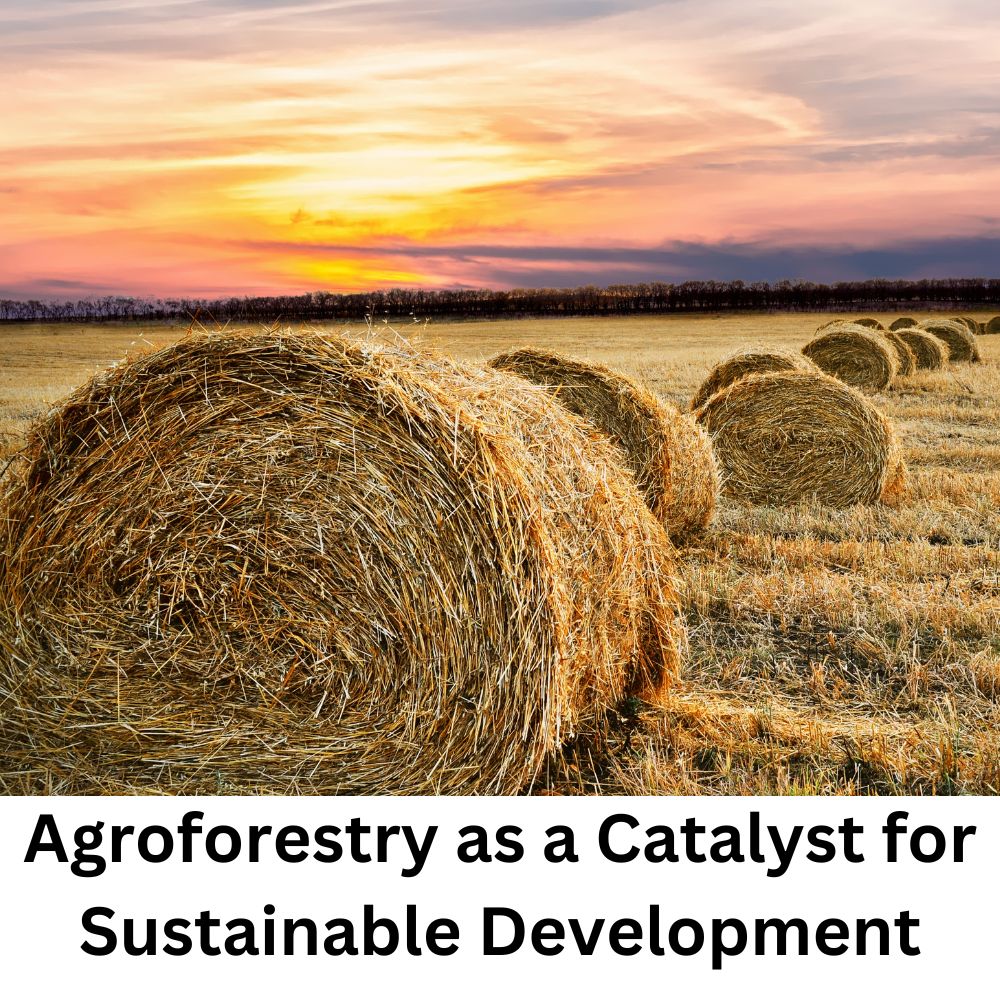Introduction
In an era marked by environmental degradation, climate change, and food security challenges, the need for innovative and sustainable agricultural practices is more pressing than ever. Agroforestry, a system that combines trees, crops, and livestock on the same land, has emerged as a powerful catalyst for sustainable development. This article explores the concept of agroforestry, its potential to drive positive change, and its role in addressing the interconnected issues of environmental conservation, food security, and economic development.
Agroforestry Defined
Agroforestry, often called a “land use system with trees,” integrates various elements of agriculture and forestry to optimize land productivity and ecosystem services. Unlike conventional monoculture farming, where a single crop is grown, agroforestry systems involve strategically cultivating trees alongside crops and, in some cases, including livestock. This diversification enhances farm productivity and promotes ecological sustainability and resilience.
Key Components of Agroforestry
- Trees: Trees play a central role in agroforestry. They provide multiple benefits, such as shade, windbreaks, and nutrient cycling. They also sequester carbon, mitigate climate change, and offer valuable products like timber, fruits, nuts, and medicinal plants.
- Crops: The cultivation of annual or perennial crops within agroforestry systems complements the presence of trees. Crops benefit from improved microclimates and nutrient-rich soils created by tree canopy cover.
- Livestock: Integrating livestock, such as cattle, goats, or chickens, into agroforestry systems enhances nutrient cycling and improves the overall sustainability of animal farming.
- Biodiversity: Agroforestry promotes biodiversity by creating varied habitats for plants, animals, and insects. This natural diversity helps with pollination, pest control, and nutrient cycling, reducing the need for synthetic chemicals.
Agroforestry for Sustainable Development
Agroforestry holds the potential to catalyze sustainable development in several critical areas:
- Environmental Conservation:
- a. Carbon Sequestration: Trees in agroforestry systems sequester carbon dioxide from the atmosphere, mitigating climate change and enhancing carbon storage in soil and biomass.
- b. Soil Health: Tree roots improve soil structure, reduce erosion, and enhance nutrient cycling, leading to healthier and more fertile soils.
- c. Biodiversity Preservation: Agroforestry fosters diverse ecosystems, creating habitats for various species of plants, animals, and insects.
- d. Reduced Chemical Use: Enhanced biodiversity and nutrient cycling in agroforestry systems can reduce the need for synthetic pesticides and fertilizers, decreasing environmental chemical pollution.
- Food Security:
- a. Diversified Diets: Agroforestry systems offer various food products, including fruits, nuts, vegetables, and animal products, contributing to diversified and more nutritious diets.
- b. Stable Yields: Trees provide shade and windbreaks, protecting crops from extreme weather conditions and ensuring more stable yields.
- c. Income Diversification: Agroforestry diversifies income sources for farmers by selling tree products, improving economic resilience.
- Economic Development:
- a. Value-added Products: Agroforestry provides opportunities for value-added processing of tree products, such as timber, fruits, and nuts, creating jobs and income.
- b. Market Access: The diversity of products generated in agroforestry systems can open up new markets for farmers, reducing dependency on a single commodity.
- c. Rural Empowerment: Agroforestry strengthens rural communities by increasing income, improving livelihoods, and reducing migration to urban areas.
Case Studies of Agroforestry Success
- The Kenyan Green Belt Movement:
- Founded by Nobel laureate Wangari Maathai, the Green Belt Movement in Kenya focused on tree planting and agroforestry as tools for environmental conservation and rural development. Over several decades, the movement mobilized women to plant millions of trees, combat deforestation, and provide communities with sustainable income sources. This grassroots initiative showcases the transformative potential of agroforestry in addressing environmental and social challenges.
- Indonesia’s Agroforestry Revolution:
- Indonesia has embraced agroforestry to combat deforestation and promote sustainable land use. The government’s efforts, combined with those of local communities, have led to the restoration of degraded lands through tree planting and agroforestry practices. This approach has improved the environment and empowered rural communities by providing new livelihood opportunities.
- Brazil’s Shade-Grown Coffee:
- In Brazil, agroforestry practices have been successfully integrated into coffee farming. Shade-grown coffee plantations, where coffee plants thrive under the canopy of native trees, have gained popularity. This method not only enhances the quality of coffee beans but also preserves biodiversity and provides habitat for migratory birds. It demonstrates how agroforestry can promote sustainable agriculture while protecting ecosystems.
Challenges and Considerations
While agroforestry offers substantial benefits, its widespread adoption faces particular challenges:
- Knowledge and Training: Farmers may need training and support to implement agroforestry systems effectively.
- Land Tenure: Land ownership and tenure issues can hinder agroforestry adoption, especially in regions with unclear land rights.
- Market Access: Developing markets for agroforestry products may require concerted efforts to establish supply chains and create demand.
- Policy and Regulation: Governments must formulate supportive policies and regulations that incentivize agroforestry adoption and sustainable land management.
Conclusion
Agroforestry is not merely a farming technique but a holistic and transformative approach to sustainable development. By embracing agroforestry, we can simultaneously address pressing global challenges, including climate change, environmental degradation, food security, and economic development.
The stories of success from different corners of the world highlight agroforestry’s capacity to change lives and landscapes positively. However, we must invest in education, research, supportive policies, and community engagement to unlock its full potential. Agroforestry is a testament to the power of nature-inspired solutions and a beacon of hope for a more sustainable and prosperous future. The “leaves of change” can transform our world for the better.
